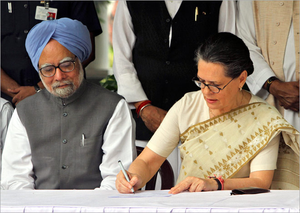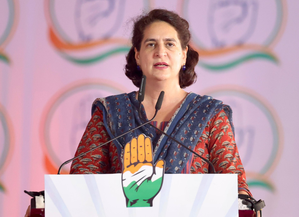New Delhi : One of the major demands that the protesting farmers are raising is to increase the work days from the existing ‘100 days’ to ‘200 days’ each year under the Mahatma Gandhi National Rural Employment Guarantee Act (MGNREGA).
If the number of work days is doubled, the payout under the scheme would be to the tune of Rs 1.4 lakh crore. The Congress-led opposition alliance, the INDIA bloc, rushed to back the demand, saying that it is doable. But while doing so, it exposed its own duplicity on this scheme.
There are several key facts in the light of which it could be said that the Congress and the opposition bloc are, in fact, ‘misleading’ the farmers.
One of the facts is that some members of the Sonia Gandhi-led NAC had slammed the erstwhile United Progressive Alliance (UPA) regime for what they called “undermining the NREGA by modifying several provisions of the law”.
These members were Jean Dreze and Aruna Roy.
The National Advisory Council (NAC) was a body which was constituted by the UPA-I government with the mandate to advise then PM Manmohan Singh.
Sonia Gandhi was the chairperson of the body for much of the tenure of the UPA regime. The opposition at that time used to accuse the NAC of running a parallel government with Sonia being dubbed as a ‘super PM’.
Another important fact that brings Congress’ ‘hypocrisy’ to the fore is that the Congress-led UPA government had frozen minimum wage, which used to be paid under this scheme at Rs 100 in 2012. As a result, the payout under NREGA was lower than the minimum wage in the states.
The then Additional Solicitor General, Indira Jaising, had significantly remarked, “Anyone paid less than the country’s minimum wages was into forced labour.”
This was a prosecutable offence. It means the UPA’s move to lower wages amounted to reducing workers to the status of enslaved labour. UPA’s initial betrayal of farmers had its repercussions, as MGNREGA wages are now virtually delinked from statutory minimum wages.
The Rural Development Ministry and the National Employment Guarantee Council (NEGC) during the UPA rule in January 2013 had rejected the recommendations that NREGA wages should be indexed on minimum wages for agricultural workers. The wage rate recommended was Rs 125. Was the UPA happy to ‘cheat’ agricultural labourers of their dues?
Labourers under UPA’s NREGA were paid on the basis of the number of pits dug or other measurable parameters. Very often an individual’s work was clubbed with the work done by all workers at the site and payment was made on the “average” work done.
The National Employment Guarantee Council set up under NREGA, which was to be a watchdog of the scheme, was not free and independent at the same time. Moreover, the advice it came up with was hardly taken into account by the then UPA government.






Related Posts
Priyanka Gandhi says BJP talking of ‘tinkering’ with Constitution with PM’s nod
PM Modi says BJP-NDA leading 2-0 after first two phases
26/11 prosecutor to Mumbai North Central candidate – Ujjwal Nikam all set for ‘new innings’ with BJP